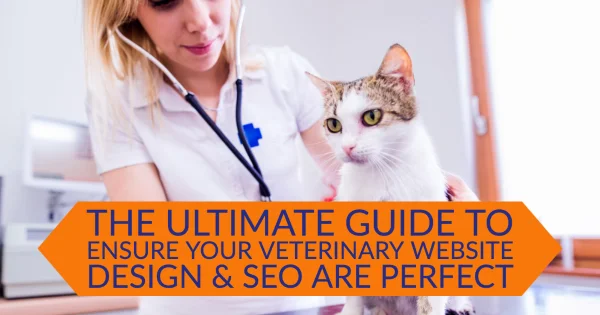If you own a veterinary practice, you know how difficult it can be to attract new customers and keep them coming back. Word-of-mouth marketing and billboard advertising can plant the initial seed for a potential customer to know what your business is and what it may offer. However, you need an optimized website with a high-quality design to truly capture the attention of the customers you want.
Website design and SEO are key factors in your veterinary practice’s marketing plan. So, how can you ensure they’re perfect? Keep reading to understand the importance of website design and SEO and how they can make or break your website’s impact.
Table of Contents
What Does Good Website Design Look Like?
Your veterinary website design will attract customers if it’s done right. A good website will:
- Be easily navigable
- Be mobile-friendly
- Have simple and clear formatting in terms of both content and pictures
- Be easy to read
- Have quick loading times
- Contain a color scheme that doesn’t take away from the content
Best Practices for Successful Website Design
Now that you know what a good website consists of, let’s break it down into simple tasks.
- Build a navigation bar that is clear and easy to understand. For example, your navigation bar may consist of the terms Home, About, Contact, Services, Resources, and Blog. Under Services, subcategories for your veterinary practice’s services can be listed, such as Wellness, Vaccinations, Surgery, Emergency Services, and more. When the navigation bar is easy to understand, potential customers won’t have a problem seeing what your vet business offers and navigating to your Contact page to book an appointment!
- Make the website accessible and mobile-friendly. People of all ages and abilities have pets that need to be taken to the vet. This is why you need an accessible, mobile-friendly website that anyone can easily access and read. An accessible website will use a distinct color scheme, have easy-to-read fonts and text colors, and be easy to scroll through. Mobile friendliness is key as well because customers should be able to visit your veterinary website on any device they choose.
- Format the content on the website. The content on your website should be easy to read. This means that the content needs to be formatted with readers in mind. Use different size text for headings, subheadings, and paragraphs. Headings should be clear so that readers can easily jump to what information is relevant to them. It’s also a good idea to use numbered or bulleted lists when possible, as they’re easy for readers to scan.
- Ensure the website has fast loading times. Nobody wants to wait more than a few seconds for a website to load. In fact, most web users will look for a different website than wait for another to load. This is why your veterinary practice’s website must have fast loading times.
- Make forms visible and easy to fill out. Many businesses have forms on their websites so interested customers can fill out their contact information for a follow-up. If this is something you’d like to offer potential customers of your veterinary practice, ensure all forms can easily be accessed, filled out, and submitted. You don’t want a potential customer to have a headache trying to fill out a form that doesn’t work because they’ll likely navigate to a different website.
- Add fun and personable photos. As a veterinary practice, potential customers want to see that you’re passionate about your work and the animals you work with. This is why adding fun photos of patients can draw in more customers. With customer permission, add photos of current animals you work with on a regular basis (ask us how to easily collect media releases from your clients!). Include some spirited captions so potential customers can see you love the animals you work with!
- Add client testimonials throughout the website. Adding customer reviews to your website is a great way for potential clientele to see the kind of work you do. It’s important to have a page on your website dedicated to these testimonials. However, you can also add previews to these reviews on various pages on your website. This way, a potential customer can read a preview of a review and click on a link that takes them to the rest of them. 85% of consumers read online reviews before making a buying decision, making reviews a critical factor in turning website visitors into scheduled clients (Source: BrightLocal).
What Your Website Needs to Include
Web design is more than how it looks. It also has to do with how the website operates. To ensure your veterinary practice’s website reaches its full potential, it should have:
- Excellent error handling. When an error occurs, you want a message to come up that makes the problem clear to the reader. This improves the web user’s experience on your website.
- Consistency across all web browsers. The website should look and operate the same whether a person is using Safari, Chrome, or Mozilla Firefox on their laptop, computer, cell phone, or tablet.
- Clean coding. This makes your website easy to navigate and find online, helps with loading times, responsiveness, and more.
- Proper URLs. Ensure your website has an SSL Certificate and that you are using HTTPs for your website, as it improves your website’s security and by extension, its ranking in search results.
- Effective SEO techniques. Let’s dive into SEO and its importance below.
What Is SEO and Why Does Your Website Need It?
Search engine optimization (SEO), when implemented correctly, will improve the quality and quantity of traffic to your veterinary business’s website organically. Organic traffic is unpaid. When you use proper SEO techniques on your website, your website will get more traffic, its search engine rankings will increase, and you’ll get more customers!
SEO is one of the most important aspects of any business’s website. It is a long-term strategy; so, slowly and steadily, it will help your veterinary practice’s website perform better and better. However, it takes the right techniques to improve your website and its rankings.
Best SEO Practices for Your Veterinary Practice’s Website
Here are the most important veterinary SEO practices your veterinary business’s website needs to follow:
- Research and select the right keywords. A lot of research goes into finding the right keywords for a particular business and its website. For example, if you own a veterinary practice in Rochester, NY, you’d likely look to keywords like “veterinarian Rochester NY,” “animal hospital Rochester NY,” and “best veterinary practice Rochester NY.” For a business that is targeting a particular geographic area, it’s important to research keywords with that location in them. You may also target potential customers in surrounding areas. Essentially, performing proper keyword research can drastically improve your chances of ranking on those keywords.
- Properly map the keywords. Using keywords doesn’t end with research. After the right keywords have been selected for your veterinary practice’s website, they need to be mapped correctly. For example, “veterinarian Rochester NY” would likely be mapped to your website’s home page because it is the broadest keyword, or what we refer to as your “occupational” keyword. A keyword like “emergency vet Rochester NY” would be mapped to the “Emergency Services” services page. A keyword like “veterinary tips” could be mapped to a page on your website that offers care tips for new pet owners. It’s also important to keep in mind that only a few keywords should be mapped to each page, as they’ll be more likely to rank if the quality outweighs the quantity of the keywords.
- Optimize for “near me” keywords and voice searches. Technology is constantly evolving, which means more people will be using the voice search option on their smartphones to look up the services they seek. This is why you need to optimize your veterinary practice’s website for “near me” and voice searches, and ensure you are paying attention to your Local SEO as well. Don’t know what “local SEO” is? We can help!
- Naturally integrate the keywords into the website’s copy. Keyword stuffing is an older SEO tactic that results in the distrust of search engines, which will hurt a website’s rankings. This is why keywords need to be naturally integrated into your veterinary practice’s website copy. For example, you don’t want a sentence that drops in a keyword just because it needs to be on the page. You want it to sound natural. For example, if you wanted to integrate the keyword “emergency veterinary services Rochester NY” naturally into the copy on your Emergency Services page, you could write: “Bring in your dog for emergency veterinary services that Rochester, NY pet owners can count on.” This way, the geo within this keyword doesn’t sound awkward. Writing carefully and thoughtfully will ensure the copy on your veterinary practice’s website reads well.
- Ensure keywords are used in meta descriptions, title tags, headings, and URLs. Every SEO page on your website should have its own meta description, title tag, major heading, and URL string. Meta descriptions and title tags appear on search engine search results, so it’s important they are written correctly and contain the right information.
- A meta description describes the page’s purpose or service and includes a call to action. For example, an Emergency Services page with the “emergency veterinary services Rochester NY” keyword could have a meta description that reads: “Smith Vet offers emergency veterinary services Rochester, NY pet owners can count on. Contact us today to learn more about our trusted services.” Best SEO practice for meta descriptions involves writing between 120 and 160 characters.
- Title tags are the words that appear in a tab when you’re on a webpage. Title tags should be under 60 characters. For the same scenario above, a proper title tag would read: “Emergency Veterinary Services Rochester, NY | Smith Vet”. The keyword should be followed with its geo, a spacer, and the name of the business.
- Every page on a website should have a major heading that describes the main idea of that particular page. Typically, H1s are used. The H1 for the scenario above could read: “Dependable Emergency Veterinary Services In Rochester, NY”. You want to keep H1s on the shorter side, using an adjective that positively describes the offered service. It’s a good idea to include the geo when possible, too.
- Every URL for your website should accurately reflect the page it is associated with. For example, a URL for the scenario above could read: “https://smithvet.com/services/emergency-veterinary-services”. Ensure all pages on your website are nestled in the correct folder. All services should be under a “Services” folder in your navigation bar, and this should be reflected in the URL strings. It’s best practice to keep URL strings short and to the point so web users can easily get a main idea of the page they’re navigating by simpling reading the URL.
- Only publish high-quality content. On a similar note, the copy on your website should be well-written. You want every page to have useful information for readers. For example, your home page should welcome visitors to your business. It should provide an overview of your veterinary practice’s services as well as contact information. Each service page should provide a detailed description of what each service entails. Remember that potential customers want to see that you are passionate about providing veterinary care, so ensure all of the copy on your website is well-written and makes sense for your audience.
- Include internal links throughout your website. To make navigation easier for potential customers, it is best practice to include internal links throughout your veterinary practice’s website. For example, when you write “Contact us today!” on your website’s home page, this call to action should be linked to your website’s Contact page. The same goes for discussing various services you offer on your home page. It’s a good idea to link each service so that readers can easily click on the service they’re most interested in and learn more about it on the page with the most information about it. Internal links are not only good for customer accessibility. It is also a good SEO technique because they help search engines understand your website and business better and, therefore, rank your website higher.
- Include photos and videos on your website. Including photos and videos on your veterinary practice’s website isn’t only good for the website’s visual appearance. It’s also a great way to optimize your website. Images and videos make your website’s content more interesting for web users, which will increase engagement and traffic as well as show search engines that your website is trustworthy. You should also use descriptive image names and include alternative text for each image using the keyword associated with the page the image is on.
- Research, research, research. Research is a very important aspect of proper SEO. Apart from researching the best keywords to use for your own veterinary practice’s website, you also need to analyze how those keywords are performing on a regular basis. You may want to compare your keyword rankings to your competitors to see how you can improve your website’s SEO as well. Measuring your results will help your website rank higher over time.
- Earn backlinks to your website. A backlink is a link from one website to another. When your business is linked on trustworthy, high-ranking websites, search engines will view your website as trustworthy as well. Earning backlinks takes patience, though. There are many ways to earn backlinks, like offering to write guest posts for other websites and doing link exchanges. It’s important to keep in mind that quality is much more important than quantity when it comes to earning backlinks. Having a bunch of low-quality links to your websites on spammy-looking websites will actually hurt your website’s credibility and search engine rankings. Instead, consider partnering with other businesses in your area that you trust, and adding links to each other’s websites on a resources page.
Invest in High-Quality Website Design and SEO Services for Your Veterinary Practice Today
Your veterinary practice’s website design and SEO are both crucial to your website and your business’s success. When your website is properly designed and optimized, more users will find your website, read through its content, decide you’re a trustworthy business, and become a customer. To learn more about improving your veterinary practice’s website, contact ViziSites. We offer high-quality marketing services for veterinary businesses across the country. Hire us today for excellent marketing services that’ll put your veterinary business on top!














